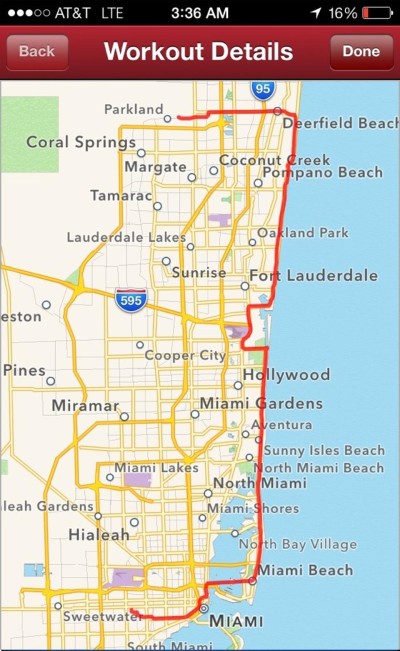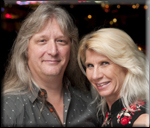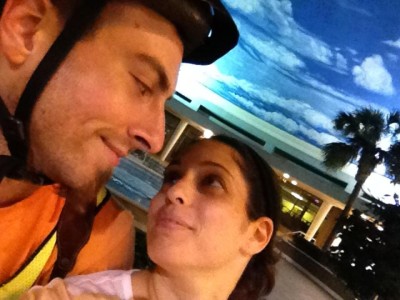
This past Sunday night, my fiancé, Naomi and I embarked on a 65 mile bicycle journey along A1A from Parkland to Coral Gables. The propose of the trip: to see if we could do it.
I will preface this by saying that I’ve made October my personal “No Car, No Facebook Month”, also to see if I could do it (more on this in a future post). Naomi was gracious enough to go along with my scheme to bike the entire east coast of Miami-Dade and Broward Counties. We live in the middle of suburban Coral Gables, and regularly bicycle commute as far as Little Haiti, Wynwood, Downtown and Miami Beach, but by no means, had we been training for a long distance ride like this one.
For many of us entrenched in the suburbs, the heavens have granted us sparse access to public transit and the mindset that the car is the only thing that belongs on the road. In my daily commutes, I experience the brunt of this life philosophy from the seat of my bicycle in the form of honking, shouting, and cutoffs from passing drivers. I’ve grown accustomed to threatening gestures at least once per trip, and I’ve accepted that where I live, I am no longer a human being like everyone else. Instead, I am an obstacle on a child’s two-wheeled contraption, somehow preventing people from getting where they need to go. In reality, the offenders comprise a very small slice of the driving population, but the frequency of incidents sometimes makes me forget this.
We left my parents house in Parkland, and before long, joined 55mph traffic on Hillsborough Blvd’s narrow bike lane heading east. Drivers honked and cars overstepped stop lines when we crossed intersections. Shattered glass, plastic eating utensils, car parts, and even an old handbag littered our path, often forcing us temporarily into car travel lanes to avoid puncturing our tires or wiping out on the curb. At least the weather was cool and breezy that day. The sidewalks were virtually lifeless, especially along places with expansive parking lots like the one at the local Target.
Just when our bodies began to run short of adrenaline from our death-defying journey east, we crossed the train tracks. These very tracks, the ones the TriRail uses to traverse South Florida’s east coast, also demarcate the suburban from the urban. For most people, this means you will no longer see cookie-cutter houses, vast expanses of lawn and oversized strip malls. For cyclists, this means that streets are safer for you as someone who rides unprotected by 2 tons of aluminum. Drivers in urban areas are accustomed to seeing pedestrians and cyclists as human beings, and will slow down to accommodate them. Also, urban areas tend to be much more interesting to watch, and will make a ride feel shorter. Crossing those tracks was like walking a long tightrope surrounded by blind flying hammers, and making it to safety to the other side. Completing the first 40 minutes of the ride was cause for celebration.
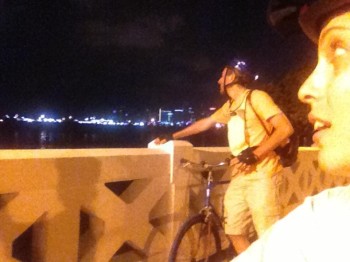
I describe the 20 mile bike ride from Deerfield Beach to Lauderdale by the Sea as one of the most romantic experiences Naomi and I have experienced in our 8 years together. We stopped at interesting shops along the way, had mini-picnics on the side of the road, and waved to crowds of people gathered at bars. The transition from Hillsborough Beach to Lighthouse Point guided us through winding sea grape canopies that opened up to vistas of water on both sides of us. On one end of the spectrum, we saw mansions and yachts. On the other end, we saw tiki huts and schooners. To update our friends and family, we took pictures at every “Welcome to Whatever City” sign we saw along our route. During this leg of the trip, not a single person honked at, heckled, or tried to run us off the road. One couple of motorists even cheered us on.
Our idyllic adventure came to a pause when we crossed the bridge from Lauderdale by the Sea inland to get around Port Everglades, which, on a map, looks like it sliced right through A1A. We stopped atop the bridge to admire the cruise ships docked in the distance, and reassure ourselves of our route.
“The map says we can make a left onto Federal Highway in a few blocks, and once we get to Dania, we can get back onto A1A after passing the sea port. Federal Highway looks like it should be a regular three-lane road like Hillsborough Blvd, so it probably has a bike lane.”, I assured Naomi before we coasted down the bridge and through a gauntlet of weaving cars and stop lights. We learned that the bridge is also one of those urban/suburban demarcation lines just like the train tracks. We submerged ourselves into the suburbs where people who drive treat people not driving like objects. Amidst a barrage of honks, a car passenger stuck his head the window and shouted, “There’s a sidewalk for a reason!”.
Southward a few blocks, Federal Highway unexpectedly stripped itself of buildings and sidewalks. We suddenly found ourselves in the center lane of what felt like an expressway on-ramp with no way out but forward. Airplanes and fuel silos flanked us on either side, and we battled uphill to escape 70mph traffic. We paused for an emergency meeting on the highway shoulder. Of course, we also stopped to take a picture =).
“We’re the only idiots to ever ride bikes out here.” Naomi said. “There’s got to be a better way to do this.”
I followed up, “If we stay on the shoulder, we can follow this bridge as it curves around and goes over that river. Deerfield is right there. We can’t turn around.”
We agreed and pressed on. Drivers on the highway don’t honk at cyclists. We imagined out loud that drivers on the highway would either be too shocked at the site of cyclists on the highway to press the horn quickly enough, or that they’re too busy texting to see us. Rounding the bend, the highway shoulder narrowed and became gravel-filled. Side note: sand and gravel are the arch nemeses of cyclists. Turning your handlebars more than a few degrees on gravel could cause a bike to careen sideways and eject its master into oncoming traffic. “ZOOM… ZOOM” the cars sped by. “Road work ahead!” shouted Naomi over the sounds of motorists. Barricades suddenly blocked our gravel-laden shoulder. We opted not to ride in the travel lane, and carefully carried our bikes between and around Bob’s barricades for a quarter mile. Thanks a lot, Bob.
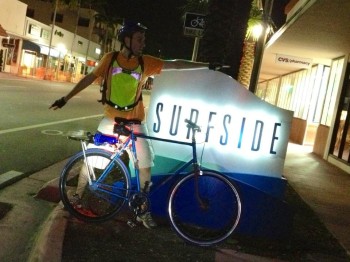
Serene, pleasant, and filled with the smell of ocean air, Danie Beach carried us to Hollywood Beach, which carried us to Golden Beach, across the Miami-Dade County Line to Sunny Isles Beach, Bal Harbor and eventually, Miami Beach. By midnight, Sunday, A1A drivers were scarce, leaving us plenty of room to ride uninterrupted, side by side, for miles.
We made some casual observations on our journey, but we didn’t do any quantitative tracking to back up these claims.
1. Drivers are more likely to be talking on or looking at their cell phones in suburban areas than they are in urban areas. I noticed this occasionally when checking out passing vehicles or peering through windshields at stop lights.
2. Public spaces are generally in better condition in urban areas. We noticed a lot of trash in the bike lanes and swales along our suburban routes.
3. Pedestrians and drivers we waved to in urban areas, especially along the beachfront, are more likely to reciprocate than they are in suburban areas. In the suburbs, people generally look at you suspiciously if you’re too friendly.
4. There’s a black and white bulldog that watches the street from the roof a small hotel/condo-looking building somewhere between Pompano Beach and Lauderdale by the Sea on the ocean side. I forgot to note exactly where this was. If anyone knows what I’m talking about, please comment below.
5. Hotels and drugstores are very welcoming when you need a restroom break.
This excursion provided much insight for me as an urbanist, who designs places for people. My experience in the field gives me the understanding that our culture shapes our places, and our places, in turn, shape our culture. We have built places like expressways and big box parking lots that are so unbearable for humans, that few will dare go to them without a personal automobile. We’ve built these inhospitable places so we can get to the places we really want to go, like the grocery store or the walkable beach town. I offer that we don’t need so many parking lots and wide roads to get where we really want to go. Instead, I believe if we make the places we live and work every day as great as the places we dream of visiting on the weekend, we would dedicate more land to making human-friendly places, and less land to asphalt. One may argue that I’m idealist, and that without these unfriendly places, we wouldn’t be able to get around. Good point. In much of our suburban neighborhoods, we wouldn’t be able to get around without these places. But I’m not an idealist, and I don’t believe we need to give up the freedom of traveling wherever we want to, whenever we want to. I simply believe we can provide the same or better level of freedom to commute, without wasting so many opportunities to make enjoyable places for people. Walking through Grand Central Station in New York, with all of its people-watching, dining options, retail spaces, and cultural opportunities is much better than traversing a parking lot, is it not? Can socializing on train with new interesting people be more humanly fulfilling than driving alone on the freeway? For some of us, the answer is yes. I believe we should have many transit choices readily available, for its the freedom to choose the places we inhabit that provides our liberty, and creates opportunity for human happiness to arise.
After all of the unique, friendly and walkable places we rode through along A1A that night, I ask the question, “Why haven’t we built all of our neighborhoods this way?” This kind of human/pedestrian-friendly development isn’t unique to beaches, and it isn’t very expensive to make. It occurs all over the world in all geographies in all climatic conditions. So what happened? A century ago, before our grandparents and great grandparents had cars – when they walked or took a streetcar to go to the grocery or to downtown, the people who wanted to drive fast from place to place on new interstate highways were considered idealists. Our great grandparents, with their “walkability” mindset were the realists of their time.
That brings us back to culture. The mindset of a small group of people can eventually transform a physical place or set of physical places. In this case, the mindset of futurism and progress transformed our nation of quaint little towns into a vast network of interstate highways and suburban sprawl. The unanticipated byproduct these new sprawling places and their freedom to drive through them ultimately altered the mindset of future generations, who grew up knowing only this kind of development and accepting it as “what is so.” Part of that “what is so”, is the idea that cyclists don’t belong on the road, despite what the law says.
Sprawl hasn’t turned us into bad people. It may have divided us, and made us suspicious of one another, but I take comfort knowing that human beings have the capacity to be kind to one another no matter what color we are, what language we speak, or how we choose to commute. Best of all, there are still places, like the little beach towns along A1A, that cultivate kindness.
Thanks for reading,
—
Follow me on Twitter: @blemmerman
Follow Naomi on Twitter: @misssustainable
